Themed collection Journal of Materials Chemistry C HOT Papers

Ferroelectricity in organic materials: from materials characteristics to de novo design
The development of new organic ferroelectrics has encountered some challenges and opportunities. In this perspective, we have summarised synthetic and computational design principles for high-performance organic ferroelectrics.
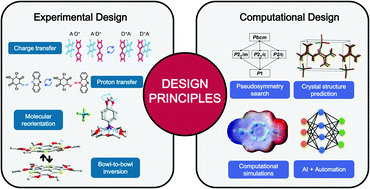
J. Mater. Chem. C, 2022,10, 13676-13689
https://doi.org/10.1039/D2TC01330D
Challenges, progress and prospects in solid state triplet fusion upconversion
Photon upconversion (UC) stands for the conversion of low to high energy photons, a promising approach to improve solar cells. While high efficiencies can be obtained in liquid UC, will a solid UC device be able to reach such levels?
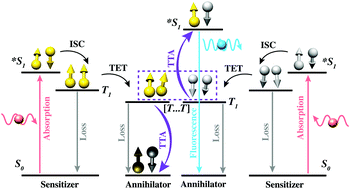
J. Mater. Chem. C, 2022,10, 7783-7798
https://doi.org/10.1039/D1TC05659J
Vertical organic transistors with short channels for multifunctional optoelectronic devices
For development of multifunctional smart devices, this perspective focuses on vertical transistors with short channels aided by nanotechnology.
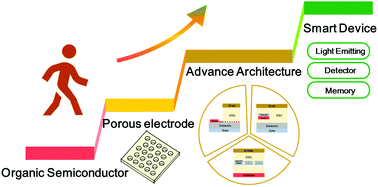
J. Mater. Chem. C, 2022,10, 2494-2506
https://doi.org/10.1039/D1TC05055A
Dopant-mediated surface charge imbalance for enhancing the performance of metal oxide chemiresistive gas sensors
A generalized picture on how surface charge imbalance mediated by doping can affect the gas sensing behavior of metal oxide chemiresistive systems.

J. Mater. Chem. C, 2022,10, 1968-1976
https://doi.org/10.1039/D1TC05144J
The electrochemical double layer at the graphene/aqueous electrolyte interface: what we can learn from simulations, experiments, and theory
The structure of the electrical-double layer of the graphene/aqueous–electrolyte interface is challenging to model and characterize experimentally. Here we review the published data and discuss their interpretation in the context of the EDL theory.
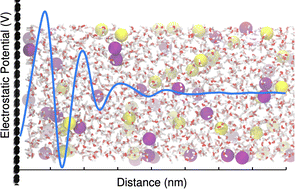
J. Mater. Chem. C, 2022,10, 15225-15262
https://doi.org/10.1039/D2TC01631A
The future of solution processing toward organic semiconductor devices: a substrate and integration perspective
This review summarizes the solution-processing techniques toward organic semiconductor devices from the perspective of the physical state of the film-forming substrates.

J. Mater. Chem. C, 2022,10, 12468-12486
https://doi.org/10.1039/D2TC02316D
Indenofluorenes for organic optoelectronics: the dance of fused five- and six-membered rings enabling structural versatility
This article reviews the historical and recent advances in the design, synthesis, and implementation of the 6-5-6-5-6 π-fused-ring indenofluorene-based semiconductors in organic transistor and solar cell devices.

J. Mater. Chem. C, 2022,10, 8496-8535
https://doi.org/10.1039/D2TC00684G
Electro-optical π-radicals: design advances, applications and future perspectives
Perspectives on carbon-centred neutral π-radicals are discussed in terms of materials design, optical and electrochemical properties, target applications and intriguing research directions that deserve further attention.

J. Mater. Chem. C, 2022,10, 7368-7403
https://doi.org/10.1039/D1TC05268C
Solvent strategies toward high-performance perovskite light-emitting diodes
Solvent engineering is playing an important role in improving the performance of perovskite light-emitting diode (PeLED) devices. In this review, solvent-based strategies for efficient PeLEDs are mainly discussed and an outlook is also proposed.

J. Mater. Chem. C, 2022,10, 3276-3286
https://doi.org/10.1039/D1TC05685A
Toward phosphorescent and delayed fluorescent carbon quantum dots for next-generation electroluminescent displays
Featuring a combination of size-tunable emission wavelengths, high thermal stability, and low cytotoxicity, carbon quantum dots (CQDs) have opened up a new possibility for next-generation displays.
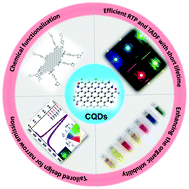
J. Mater. Chem. C, 2022,10, 2333-2348
https://doi.org/10.1039/D1TC04271H
Strong electron–phonon coupling driven charge density wave states in stoichiometric 1T-VS2 crystals
Combining chemical reaction and low-temperature annealing allows to form perfectly stoichiometric 1T-VS2, where multiple charge density wave orders are observed due to strong electron–phonon coupling.

J. Mater. Chem. C, 2022,10, 16657-16665
https://doi.org/10.1039/D2TC04186C
Highly specific fluorescent probes toward acetic acid via structural transformation of zinc complexes
Acetic acid probes based on Zinc complexes with high stability and selectivity were successfully prepared by reacting the H2tBuCarPy ligand with ZnBr2, which exhibit reversible vapor-chromism during the uptake and release of acetic acid.
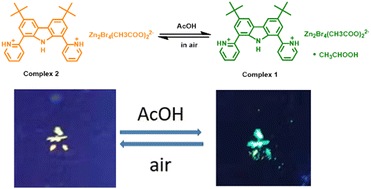
J. Mater. Chem. C, 2022,10, 16666-16669
https://doi.org/10.1039/D2TC04250A
Efficient pure near-infrared organic light-emitting diodes based on tris(2,4,6-trichlorophenyl)methyl radical derivatives
An OLED based on TTM-3PDMAC achieved a maximum external quantum efficiency (EQE) of 3.1% with an emission peak at 830 nm.

J. Mater. Chem. C, 2022,10, 14116-14121
https://doi.org/10.1039/D2TC03299F
LaBS3 revisited: a promising mid-infrared nonlinear optical material
LaBS3 possesses a large SHG effect, high laser-induced damage threshold, wide band gap, and high thermal stability.

J. Mater. Chem. C, 2022,10, 12556-12559
https://doi.org/10.1039/D2TC02699F
Bipolar single-component Sm3+-containing metallopolymers capable of multi-stimuli-responses
By the molecular design of a bipolar single-component Sm3+-containing metallopolymer, its light/electricity stimuli white-light and visual sensing on Cu2+ ion, render Ln3+-containing metallopolymers a new platform to multi-stimuli-response materials.

J. Mater. Chem. C, 2022,10, 11175-11180
https://doi.org/10.1039/D2TC02360A
Reconfigurable self-powered imaging photodetectors by reassembling and disassembling ZnO/perovskite heterojunctions
A facile dry-transfer method is developed to construct reconfigurable self-powered photodetectors. Benefitting from the reconfigurability of these individual building blocks, they can be assembled into multifunctional pluggable photodetectors.

J. Mater. Chem. C, 2022,10, 8922-8930
https://doi.org/10.1039/D2TC01419J
CsAB8O12F2·CsI (A = K+, NH4+): design of two fluorooxoborates with benign layered structures via a salt-inclusion strategy
A salt-inclusion strategy was adopted to construct two novel fluorooxoborates CsAB8O12F2·CsI (A = K+, NH4+). Therein, CsKB8O12F2·CsI shows moderate SHG response (0.6 × KDP at 1064 nm) and short phase-matching (PM) SHG wavelength (270 nm).

J. Mater. Chem. C, 2022,10, 8584-8588
https://doi.org/10.1039/D2TC01598F
Modulation of triplet-mediated emission from selenoxanthen-9-one-based D–A–D type emitters through tuning the twist angle to realize electroluminescence efficiency over 25%
Increasing the twist angles between donor and acceptor units in 9H-selenoxanthen-9-one-based emitters can modulate the lowest triplet excited states (3LE or 3CT), achieving pure RTP and dual emission of RTP and TADF, respectively.

J. Mater. Chem. C, 2022,10, 7437-7442
https://doi.org/10.1039/D2TC00899H
[C3N6H7]2[B3O3F4(OH)]: a new hybrid birefringent crystal with strong optical anisotropy induced by mixed functional units
A new hybrid fluorooxoborate was discovered following the strategy of combining two birefringence-active units. The large birefringence and short absorption edge make it a potential short-wavelength ultraviolet birefringent crystal.
![Graphical abstract: [C3N6H7]2[B3O3F4(OH)]: a new hybrid birefringent crystal with strong optical anisotropy induced by mixed functional units](/en/Image/Get?imageInfo.ImageType=GA&imageInfo.ImageIdentifier.ManuscriptID=D2TC01123A&imageInfo.ImageIdentifier.Year=2022)
J. Mater. Chem. C, 2022,10, 6590-6595
https://doi.org/10.1039/D2TC01123A
Deformable, sensible, and reconfigurable microgels with structural color: potential as camouflage soft microrobots
Topological heterogeneous microgels have been obtained via self-assembly of stimuli-responsive, semi-confined space processing block copolymers. The synergistic capabilities have been integrated into a microscale entity for the first time.
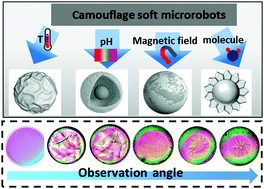
J. Mater. Chem. C, 2022,10, 5070-5078
https://doi.org/10.1039/D2TC00142J
Nematic liquid crystals induce and amplify the circularly polarized luminescence of chiral TADF emitters
High luminescence dissymmetry factors of +7.26 × 10−2 and −5.45 × 10−2 of chiral thermally activated delayed fluorescence emitters were obtained by co-assembly with achiral liquid crystal molecules.

J. Mater. Chem. C, 2022,10, 5065-5069
https://doi.org/10.1039/D2TC00344A
Near-infrared-to-visible upconversion from 980 nm excitation band by binary solid of PbS quantum dot with directly attached emitter
Solid mixture of PbS quantum dot and a directly attached emitter penetrating the ligand layer enables photon upconversion from near infrared.
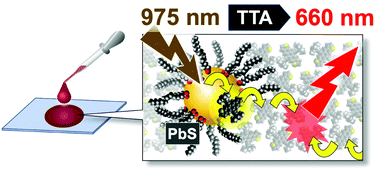
J. Mater. Chem. C, 2022,10, 4563-4567
https://doi.org/10.1039/D1TC05058C
A perylene diimide dimer-based electron transporting material with an A–D–A structure for efficient inverted perovskite solar cells
Through the combination of perylene diimide and triphenylamine moieties, a perovskite solar cell with DPT as the electronic transport material exhibited a PCE of 20.07%.
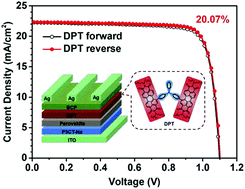
J. Mater. Chem. C, 2022,10, 2544-2550
https://doi.org/10.1039/D1TC04176B
Single crystal field-effect transistor of tetrabenzoporphyrin with a one-dimensionally extended columnar packing motif exhibiting efficient charge transport properties
The single crystal field-effect transistor of 5,15-bis(triisopropylsilyl)ethynyltetrabenzoporphyrin exhibited better hole mobility than its metal complexes, with efficient charge transport through π–π stacking along tetrabenzoporphyrin units.
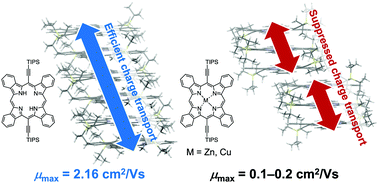
J. Mater. Chem. C, 2022,10, 2527-2531
https://doi.org/10.1039/D1TC03547A
Molecular optimization of incorporating pyran fused acceptor–donor–acceptor type acceptors enables over 15% efficiency in organic solar cells
Three acceptor–donor–acceptor type fused-ring non-fullerene acceptors of FOR-IN, FOR-1F and FOR-2F, were synthesized with the same pyran-composed backbone but different terminals, affording over 15% efficiency in organic solar cells.
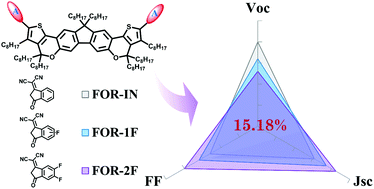
J. Mater. Chem. C, 2022,10, 1977-1983
https://doi.org/10.1039/D1TC05779K
Mn2+-doped Cs2ZnBr4 scintillator for X-ray imaging
Cs2ZnBr4:Mn2+ and its composite film demonstrate good X-ray scintillation performances with a spatial resolution of 5.06 lp mm−1 in X-ray imaging.

J. Mater. Chem. C, 2023,11, 8052-8061
https://doi.org/10.1039/D2TC04249E
Bio-inspired micro area concentrated array assisted perovskite photodetector toward weak light imaging
A perovskite photodetector with bio-inspired micro area concentrated structures has been fabricated for weak light imaging. The photodetector exhibits high detectivity (1.37 × 1013 Jones), and it can achieve weak light imaging under 0.64 μW cm−2.
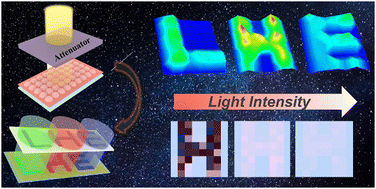
J. Mater. Chem. C, 2023,11, 8045-8051
https://doi.org/10.1039/D2TC03760B
Aggregation effects on the one- and two-photon excited fluorescence performance of regioisomeric anthraquinone-substituted perylenediimide
The isomerism effect on the aggregate emission properties of perylene diimide derivatives is studied. Banking on their bright emission, a cellular imaging test based on their nanoparticles is also conducted.

J. Mater. Chem. C, 2023,11, 8037-8044
https://doi.org/10.1039/D2TC03928A
A lanthanide-MOF based host–guest intelligent dual-stimulus response platform for naked-eye and ratiometric fluorescence monitoring of food freshness
A ratiometric fluorescent sensor, Flu@Eu-dbia, was self-assembled through host–guest interaction for the detection of tyramine. Distinguishable color change and the logic gate endowed Flu@Eu-dbia with great potential in food safety monitoring.

J. Mater. Chem. C, 2023,11, 2514-2521
https://doi.org/10.1039/D2TC04972D
Controlling dielectric properties of Nb + X (X = Al, Ga, In) co-doped and Nb-doped rutile-type TiO2 single crystals
Dielectric properties of Nb-doped TiO2 single crystals measured before and after the special post-annealing with Ga2O3 embedding powder, shedding light on local structure engineering for permittivity boosting in dielectric materials.
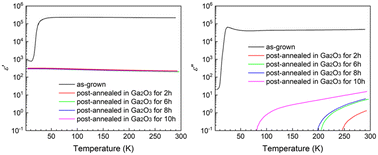
J. Mater. Chem. C, 2023,11, 1304-1310
https://doi.org/10.1039/D2TC03914A
A promising ultraviolet nonlinear optical crystal: Rb3Ba3Li2Al4B6O20F—crystal growth, physical properties, and 266 nm laser generation
The Rb3Ba3Li2Al4B6O20F crystal is a competitive ultraviolet NLO crystal, which not only can output 266 nm laser but also exhibits excellent comprehensive performances, such as large NLO coefficient, small walk-off and large acceptance angles.
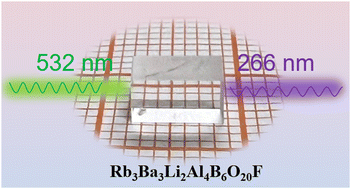
J. Mater. Chem. C, 2023,11, 1320-1328
https://doi.org/10.1039/D2TC04914G
Raman spectra of 2D titanium carbide MXene from machine-learning force field molecular dynamics
MXenes are 2D materials with many promising applications, but their Raman spectra is still poorly understood. We developed a computational method to simulate Raman spectra of MXenes accounting for temperature, surface composition, and defects.

J. Mater. Chem. C, 2023,11, 1311-1319
https://doi.org/10.1039/D2TC04374B
Microfluidic thermal flow sensor based on phase-change material with ultra-high thermal sensitivity
A microfluidic thermal mass flow sensor with ultra-high thermal sensitivity, based on planar micro-machining technology and a phase-change material is developed.

J. Mater. Chem. C, 2023,11, 1278-1284
https://doi.org/10.1039/D2TC04047F
Hollow cubic CdS@CoS/WS2 dual S-scheme heterojunction superstructure toward optimized photothermal–photocatalytic performance
Hollow cubic CdS@CoS/WS2 dual S-scheme heterojunction superstructures with a full spectral response showing good photothermal–photocatalytic properties are fabricated using a simple sulfidation and hydrothermal method.
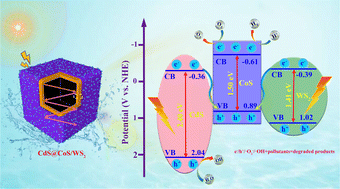
J. Mater. Chem. C, 2022,10, 18164-18173
https://doi.org/10.1039/D2TC03943E
Low dark current density in organic photodiodes achieved by reduced trap states of conjugated polymers bearing a fluorinated moiety
A strategy to obtain low Jd in OPDs from a material point of view is presented: fluorination of the electron donor unit in a donor–acceptor type conjugated polymer is an effective way to reduce the Jd of OPDs by suppressing the trap DOS.
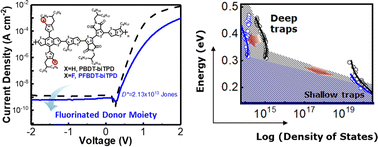
J. Mater. Chem. C, 2022,10, 18127-18136
https://doi.org/10.1039/D2TC04116B
Ultrasensitive photodetectors based on graphene quantum dot-InSe mixed-dimensional van der Waals heterostructures
Combining the advantages of GQDs and InSe, GQD/InSe 0D–2D MvdWH-based photodetectors with a responsivity of 27.48 A W−1 and a detectivity of 1.2 × 1012 Jones are proposed.

J. Mater. Chem. C, 2022,10, 18174-18181
https://doi.org/10.1039/D2TC03395J
Large scale synthesis of carbon dots for efficient luminescent solar concentrators
Hundred grams of C-dots are produced by directly heating metal citrate/urea/metal ions. The C-dots have absorption ranging from 300 to 500 nm with a QY of 70%, and a Stokes shift of 0.73 eV. These optical properties are suitable for efficient LSCs.

J. Mater. Chem. C, 2022,10, 18154-18163
https://doi.org/10.1039/D2TC04285A
Modular high power plant lighting sources based on phosphor–sapphire composites with high thermal conductivity
The desired dynamic spectra of plants can be achieved by placing PSC light convertors with different light qualities on blue LED chips.

J. Mater. Chem. C, 2022,10, 18147-18153
https://doi.org/10.1039/D2TC03275A
Identification of distinctive structural and optoelectronic properties of Bi2O3 polymorphs controlled by tantalum addition
The crystal structure and the resultant electronic structure of Ta-supplemented bismuth oxides were altered with the amount of Ta added. Their optoelectronic and redox properties were elucidated both experimentally and theoretically.

J. Mater. Chem. C, 2022,10, 17925-17935
https://doi.org/10.1039/D2TC03718A
Significant alternation of molecular structures and properties in quinoidal conjugated polymers by chalcogen atom substitution
The simple chalcogen atom substitution of quinoidal molecules and polymers induces the significant alternation of various properties as well as molecular geometries.

J. Mater. Chem. C, 2022,10, 17874-17885
https://doi.org/10.1039/D2TC04122G
A-site non-stoichiometric defects engineering in xPt–La0.9Fe0.75Sn0.25O3−δ hollow nanofiber for high-performance formaldehyde sensor
Artificially inducing abundant oxygen vacancies in perovskite-structured materials is an effective method to improve sensing activity.

J. Mater. Chem. C, 2022,10, 17907-17916
https://doi.org/10.1039/D2TC04185E
Structural influences of proquinoidal acceptor moieties on transistor performance and doping capability for diketopyrrolopyrrole-based dual-acceptor conjugated polymers
Three DPP-based dual-acceptor conjugated polymers comprising different proquinoidal heterocyclic acceptors are synthesized and their structure–property relationship using a transistor and their conductive states by doping are investigated.
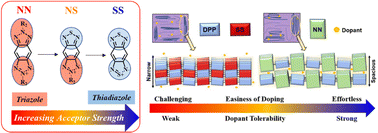
J. Mater. Chem. C, 2022,10, 17936-17944
https://doi.org/10.1039/D2TC03956G
High-performance dual-mode self-calibrating optical thermometry for Er3+, Li+ co-doped oxides
A dual-mode self-calibrating temperature measurement strategy was proposed, by leveraging the temperature-dependent ratios of UC emission intensities from the thermally-coupled and non-thermally coupled energy levels of Er3+ ions.

J. Mater. Chem. C, 2022,10, 17917-17924
https://doi.org/10.1039/D2TC04291F
Phase rearrangement for minimal exciton loss in a quasi-2D perovskite toward efficient deep-blue LEDs via halide post-treatment
With a facile halide and phase modulating approach, deep-blue emissive quasi-2D perovskite films involving fewer intervening 2D phases are realized, for efficient delivery of excitons to light-emitting phases via streamlined energy transfer.

J. Mater. Chem. C, 2022,10, 17945-17953
https://doi.org/10.1039/D2TC04025E
Highly efficient and stable binary all-polymer solar cells enabled by sequential deposition processing tuned microstructures
Sequential processing based devices show improved power conversion efficiency and stability compared to their blend casting counterparts. Systematic characterization reveals the underlying mechanism.

J. Mater. Chem. C, 2022,10, 17899-17906
https://doi.org/10.1039/D2TC04142A
Solution-processed and thickness-insensitive hole transport layer for high efficiency organic solar cells
Volatile hydrazine hydrate (HH) and non-volatile glucose (GLC) were used as n-type dopants to prepare thickness-insensitive MoOx HTLs in high performance OSCs.
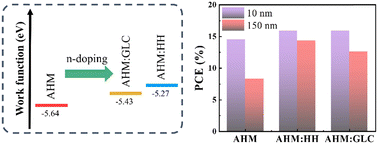
J. Mater. Chem. C, 2022,10, 17521-17529
https://doi.org/10.1039/D2TC04298C
Synthesis, characterization, and semiconducting properties of π-conjugated polymers containing hydrogen-bonded bis-pyridine-thieno[3,2-b]thiophene moieties
A hydrogen bonded pyridine-thieno[3,2-b]thiophene-pyridine type building block TTPY has been synthesized for π-conjugated polymers and their application in organic electronic devices.
![Graphical abstract: Synthesis, characterization, and semiconducting properties of π-conjugated polymers containing hydrogen-bonded bis-pyridine-thieno[3,2-b]thiophene moieties](/en/Image/Get?imageInfo.ImageType=GA&imageInfo.ImageIdentifier.ManuscriptID=D2TC03958C&imageInfo.ImageIdentifier.Year=2022)
J. Mater. Chem. C, 2022,10, 17530-17538
https://doi.org/10.1039/D2TC03958C
Enhanced photothermal stability of in situ grown FAPbBr3 nanocrystals in polyvinylidene fluoride by incorporation of Cd2+ ions
We report the enhanced photothermal stability of in situ grown FAPbBr3 perovskite nanocrystals in polyvinylidene fluoride by incorporation of Cd2+ ions, which have potential applications in backlight devices.

J. Mater. Chem. C, 2022,10, 17512-17520
https://doi.org/10.1039/D2TC04100F
TA–Fe(III) complex coated PS nanospheres for non-iridescent structural coloration of cotton fabric
In this work,monodispersed PS@TA–Fe(III) nanospheres with intense light absorption and interface adhesion were synthesized for the non-iridescent structural coloration of textiles.

J. Mater. Chem. C, 2022,10, 17472-17480
https://doi.org/10.1039/D2TC03849H
Balancing the performance and stability of organic photodiodes with all-polymer active layers
Organic photodiodes composed of all-polymer active layers achieve a stable morphology, associated with superior electrical and thermal stabilities without sacrificing their performance.
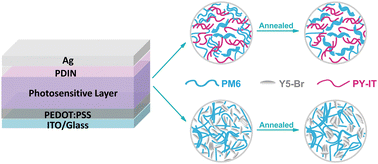
J. Mater. Chem. C, 2022,10, 17502-17511
https://doi.org/10.1039/D2TC04132D
A highly stable CsPbBr3–SiO2 glass ceramic film sintered on a sapphire plate for laser-driven projection displays
A narrow band and stable CsPbBr3 light converter was elaborately designed for laser-driven projection displays.
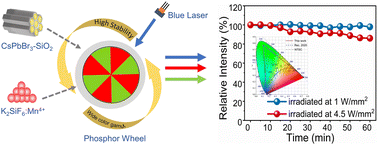
J. Mater. Chem. C, 2022,10, 17109-17118
https://doi.org/10.1039/D2TC04160J
Positive and negative electrocaloric effect in the direct and indirect characterization of NaNbO3-based ceramics with tetragonal–cubic phase boundary
A novel phenomenon of negative ΔT is observed during indirect characterization, while positive values for direct characterization.

J. Mater. Chem. C, 2022,10, 17099-17108
https://doi.org/10.1039/D2TC03915J
An S-scheme α-Fe2O3/g-C3N4 heterojunction nanostructure with superior visible-light photocatalytic activity for the aza-Henry reaction
A S-scheme α-Fe2O3/g-C3N4 composite was designed and fabricated. The α-Fe2O3/g-C3N4 showed improved photocatalytic activity for Aza-Henry reaction. S-scheme mode of charge transfer in composite enhanced the catalytic performance.

J. Mater. Chem. C, 2022,10, 17075-17083
https://doi.org/10.1039/D2TC03866H
Multifunctional all hydrogel-based smart dressing system fabricated by a self-healing cross-linking strategy for real-time monitoring of wound temperature, strain and on-demand drug delivery
A smart all-hydrogel-based dressing fabricated by a self-healing cross-linking strategy can achieve effective monitoring of wound temperature, mechanical strain and on-demand drug delivery to inhibit bacterial growth in order to promote wound healing.

J. Mater. Chem. C, 2022,10, 17084-17098
https://doi.org/10.1039/D2TC03887K
Photo-responsive liquid crystalline polymer from a renewable furfural derivative of dimethyl 2,5-furandicarboxylate via catalytic carbonylative esterification
A main chain liquid crystalline polymer has been prepared via melting polycondensation of a bifunctionalized furan monomer (DMFD) from inedible biomass with a photo-responsive azobenzene unit, which can be used in information storage.

J. Mater. Chem. C, 2022,10, 17119-17126
https://doi.org/10.1039/D2TC03965F
Ultrawide-frequency electromagnetic-wave absorption based on FeCoNiCuxMn high entropy alloys synthesized through swing ball-milling
FeCoNiCuxMn (x = 0, 0.1, 0.3, 0.5, 0.7 and 0.9) and FeCoNiCu0.1MnB0.05 high entropy alloys (HEAs) were prepared via an improved swing ball-milling method.
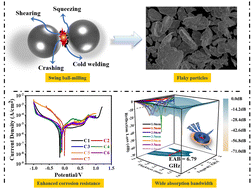
J. Mater. Chem. C, 2022,10, 16696-16705
https://doi.org/10.1039/D2TC03913C
Novel spectral band: ultraviolet A mechanoluminescence from Bi3+-doped LiYGeO4
Mechanoluminescence peaked at 355 nm (Bi3+: 3P1→1S0) was observed in an orthorhombic phase compound of LiYGeO4:Bi3+, which has widened the mechanoluminescence spectral wavelength into UV range.

J. Mater. Chem. C, 2022,10, 16670-16678
https://doi.org/10.1039/D2TC03585E
High quality lead-free perovskites toward white light emitting diodes and X-ray imaging
The luminescence mechanism of the vacancy ordered lead-free perovskite synthesized using a hydrothermal method is fully discussed. Finally, this material is applied to white light emitting diodes and X-ray imaging.

J. Mater. Chem. C, 2022,10, 16294-16300
https://doi.org/10.1039/D2TC03823D
pH-Responsive nanomicelles for breast cancer near-infrared fluorescence imaging and chemo/photothermal therapy
Responsive, efficient, and multifunctional anticancer nanoparticles were constructed for near-infrared fluorescence-guided synergistic photothermal therapy and chemotherapy.

J. Mater. Chem. C, 2022,10, 16283-16293
https://doi.org/10.1039/D2TC03749A
CuSCN as a hole transport layer in an inorganic solution-processed planar Sb2S3 solar cell, enabling carbon-based and semitransparent photovoltaics
CuSCN as HTL is used in inorganic planar carbon electrode-based Sb2S3 solar cells resulting in a higher PCE (1.95%) compared to Au (PCE = 1.75%). Also, this planar device architecture enables a semitransparent solar cell (PCE = 1.67%, AVT = 27.6%).

J. Mater. Chem. C, 2022,10, 16273-16282
https://doi.org/10.1039/D2TC03420D
Greatly enhanced stability of CsPbBr3@PbBrOH through water induction
CsPbBr3@PbBrOH with superior luminescence properties and stability was successfully synthesized by a water induction technique.

J. Mater. Chem. C, 2022,10, 15843-15850
https://doi.org/10.1039/D2TC03322D
Superior piezoelectricity and resistivity in CaBi2Nb2O9 high-temperature piezoelectric ceramics: synergy of structural distortion and weak texturing
The polycrystalline CaBi2Nb2O9 ceramics with the addition of B2O3 can realize a large d33 of 20.4 pC N−1 and an ultra-high electrical resistivity of 1.4 × 107 Ω cm (at 600 °C), while still retaining a high TC of 958 °C.
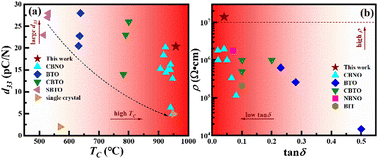
J. Mater. Chem. C, 2022,10, 15851-15860
https://doi.org/10.1039/D2TC03598G
A general approach for all-visible-light switching of diarylethenes through triplet sensitization using semiconducting nanocrystals
A simple, efficient and general approach for all-visible-light switching of photochromic diarylethenes is developed through triplet sensitization from CdS nanocrystals, which has high potential for all-visible-light activated optoelectronics.

J. Mater. Chem. C, 2022,10, 15833-15842
https://doi.org/10.1039/D2TC03582K
Antibonding induced anharmonicity leading to ultralow lattice thermal conductivity and extraordinary thermoelectric performance in CsK2X (X = Sb, Bi)
A first principles-based machine learning potential is developed to model the phonon transport properties in full Heusler CsK2Sb and CsK2Bi taking account of all higher-order phonon interactions.
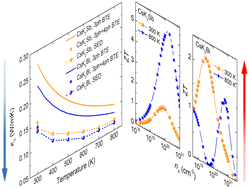
J. Mater. Chem. C, 2022,10, 15822-15832
https://doi.org/10.1039/D2TC03356A
Phase separation in alkali silicate glasses detected through inverse Laplace transform of 29Si nuclear magnetic resonance echo train decay
The ratio of Si-29 nuclear magnetic resonance coherence lifetimes for Q4 and Q3 sites under magic-angle spinning and a π-pulse train in silicate glasses can detect phase separation, even at small scales where the glass appears optically homogenous.
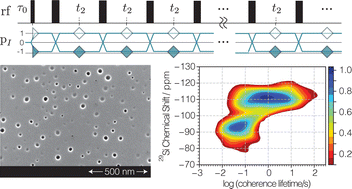
J. Mater. Chem. C, 2022,10, 15792-15805
https://doi.org/10.1039/D2TC03542A
Up-conversion charging of a Tb3+-activated garnet phosphor
An up-conversion charging process in a Gd3Ga5O12:Tb3+ persistent phosphor is achieved upon illumination by a 488 nm laser. An energy-transfer mechanism dominates the up-conversion excitation.

J. Mater. Chem. C, 2022,10, 15353-15357
https://doi.org/10.1039/D2TC03380A
In situ preparation of Bi2O2Se/MoO3 thin-film heterojunction array flexible photodetectors
The Bi2O2Se/MoO3 heterojunction has the characteristics of high stability and detection in the optical communication spectrum, which provides a simple and effective method to fabricate large-scale, fast response, broadband flexible array optoelectronic devices.

J. Mater. Chem. C, 2022,10, 15377-15385
https://doi.org/10.1039/D2TC02885A
Balancing the trade-off between the mechanical and electrical properties of conjugated polymer blend films for organic field-effect transistors
A balance between the mechanical and electrical performance is achieved in conjugated polymer blend films with an optimal blend ratio.

J. Mater. Chem. C, 2022,10, 14921-14928
https://doi.org/10.1039/D2TC01771G
Aligned chromophores in a host–guest MOF crystal for switchable polarized nonlinear optical response
By preparing a host–guest MOF to elaborately arrange donor–acceptor ligand and dye guests, second-harmonic generation and two-photon-pumped lasing can be switched in a MOF crystal by orthogonally manipulating the excitation polarization direction.

J. Mater. Chem. C, 2022,10, 14915-14920
https://doi.org/10.1039/D2TC02992H
Heterointerface engineering of tetragonal CsPbCl3 based ultraviolet photodetectors with pentacene for enhancing the photoelectric performance
The performance of CsPbCl3-based photodetector gets enhanced to a great extent after interface engineering with pentacene film. And, the mechanism was further demonstrated by experiments and DFT calculations detailedly.

J. Mater. Chem. C, 2022,10, 14892-14904
https://doi.org/10.1039/D2TC02846H
About this collection
This on-going web collection features all the articles published in Journal of Materials Chemistry C in 2022 marked as HOT (selected by our Editors as especially significant based on reviewers’ recommendations and their own appraisal). Congratulations to all the authors whose articles are featured!